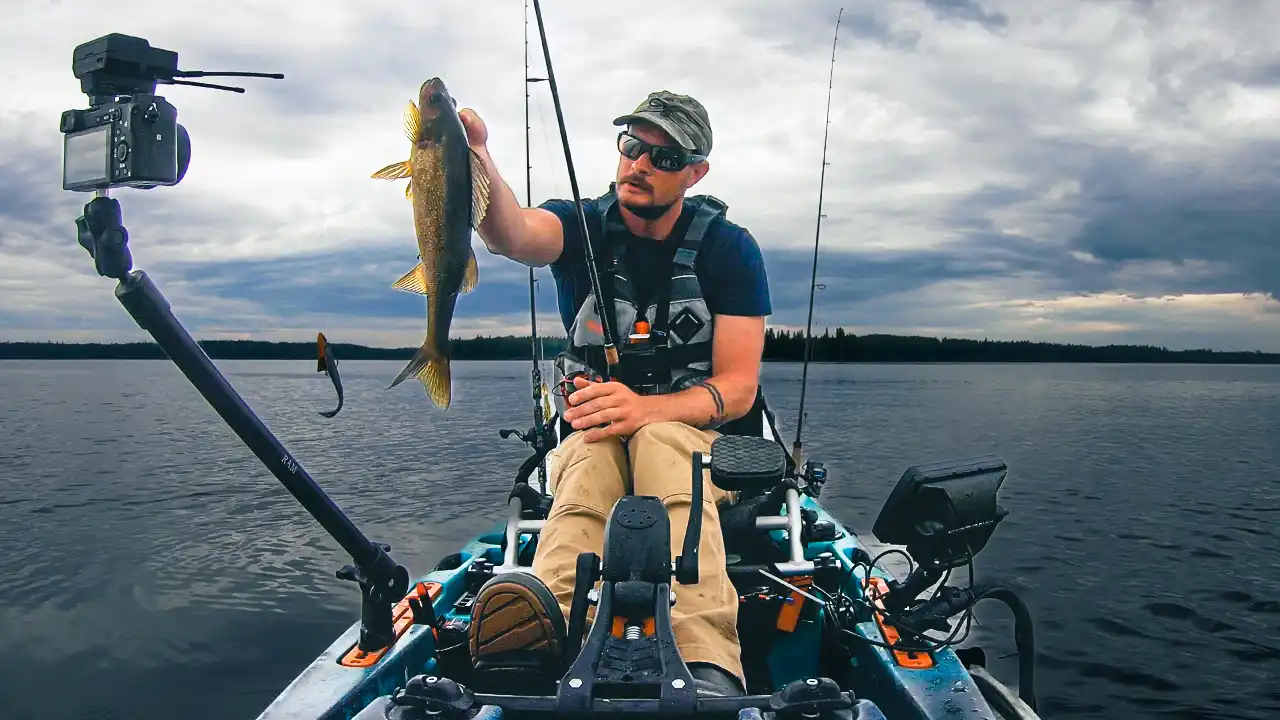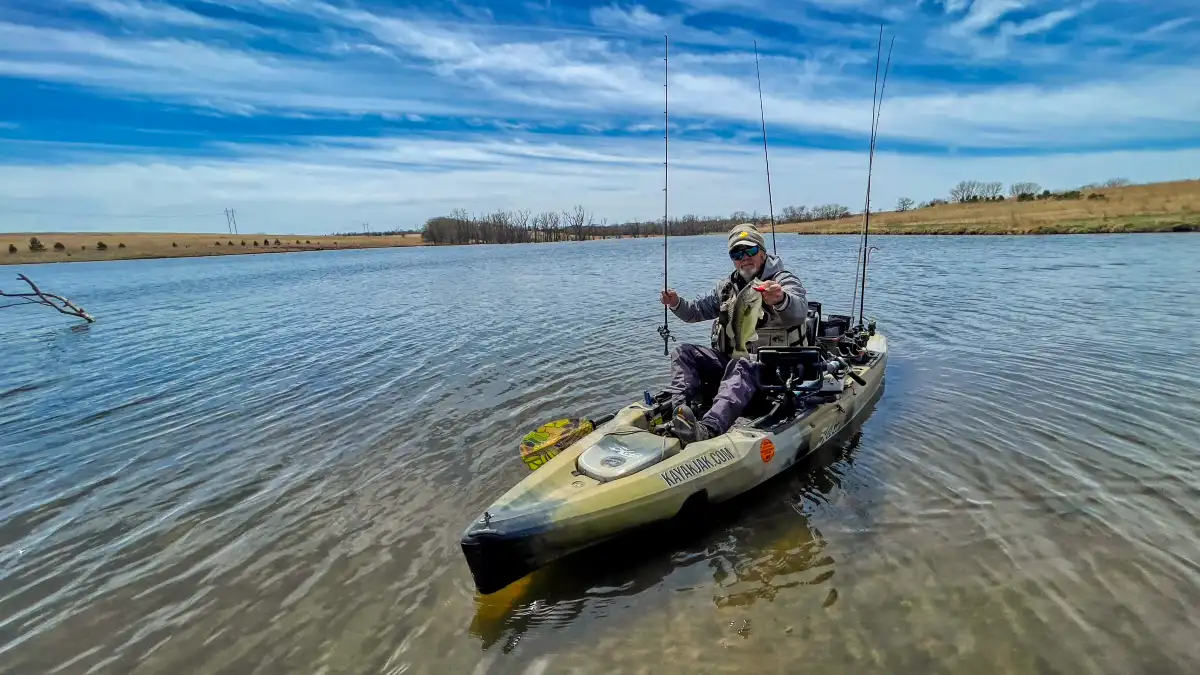Kayak fishing offers so much pleasure and joy to anglers. Being one with the water while getting that first tug of the day brings an adrenaline rush that keeps us yearning to capture more of these same moments.
At the same time we want to be sure we stay safe while on the water. The most essential piece of kayak equipment we need, on the off chance we end up in the water, would be a personal floatation device (PFD), or as it is more commonly known, a life jacket or life vest. It is vital to always wear one while fishing in a kayak. Anything can happen out on the water without a second’s notice.
Storms can hit quickly. A large branch could fall from above and knock an angler unconscious. Or just hitting something under the surface or a swift under current can cause your kayak to tip you out into the water. While capsizing seems to be the most common adversity kayak anglers face, a PFD will give you enough buoyancy to help you stay afloat as you return to the kayak or nearby shoreline. And the colder the water, the less the likelihood of a positive outcome if you go into the water without a PFD.

How to Choose a Kayak Life Jacket
Knowing we need some sort of life jacket or PFD brings us to the question: how do I choose one?
First, we must be sure to choose the correct size that will keep us safe. One might think that we should choose a PFD based on our weight and this would be true for children. But for adults, the best measurement is our chest size. The best way to measure our chest size is to take a flexible tape measure and measure the circumference of our chest from the broadest point.
With this measurement, and with the personal floatation device manufacturer’s size recommendation, you can easily find the right fit for you. There are numerous fitting guides available on the web. You can also check the label for more specific information.
It’s also important to know the federal, state, and local laws where you live before purchasing a properly fitting PFD. Remember that any child under the age of 13 must ALWAYS wear a U.S. Coast Guard-approved life vest while in the kayak or boat for that matter.
After you have found the right PFD, you will then need to find which style fits you best. With the vest style PFD, you want to be sure to loosen all of the straps first. Then put it on and zip it up. After you have the PFD secured and zipped you can then gently tighten the straps for the best fit.
A good test to be sure the vest stays on in an emergency would be to hold your arms straight up over your head and have someone try to gently pull the vest upward. If it easily pulls off over your head or rides up on the chin or face you might try a smaller size. The life jacket should fit snugly but still be a comfortable fit.
With the inflatable PFD, you should put it over your head and then tighten all of the straps. It should be snug but not to the point where it is uncomfortable to wear. Be sure that there is a CO2 cartridge in the chamber and that the gauges are showing it’s not been deployed or depleted.
For kayak anglers, the type of personal floatation device used seems to be a mixed bag of sorts. Some like the vest style PFD while many like the inflatable. There are various reasons for these preferences. But ultimately the best life jacket for kayak fishing is the one you will always wear so take some time when considering the right life jacket for your fishing kayak.

Popular Life Jacket Styles for Kayak Fishing
The vest style usually comes with lots of storage pockets where you can place items such as a knife, snacks, sun screen, phone, or other small tools needed on your fishing trip. There is usually a zipper so that you can wear it like a jacket and supplementary buckles to reinforce the security of the PFD.
It can also serve as protection not only from trees and brush but also the security in knowing that you have a floatation device that is going to keep you on the surface of the water. Most PFDs are comfortable to wear and the longer you wear your PFD the less you realize that you even have it on.
Well known kayak angler Ron Champion has been using the NRS Chinook since 2013.
“Being a large man I want something on me that I know at the end of the day will not fail me. I’m 6-foot, 4-inches tall and 300 pounds, and the Chinook will always be a staple in my equipment list. Everyone that fish’s from a kayak could (will) eventually end up in the water. Choosing a PFD that is comfortable is key for an all day fishing trip. I trust the NRS Chinook not only with my safety but also with my kids’ safety.”
Avid and well known kayak angler Kristine Fischer said, ”I like the inflatable style because it’s less restraining and less heavy on my shoulders, making for much better all day comfort.”

Life jackets for kids
When sizing a personal floatation device for children they are labeled for an infant, child, or youth. Again, the weight of the child is used to determine the right sized PFD. Inflatable PFDs are not recommended for children under 16.
Here is a simple guide to use when purchasing a vest style PFD for a child:
- Infant PFDs: 8-30 pounds
- Child PFDs: 30-50 pounds
- Youth PFDs: 50-90 pounds
Kayak Life Jacket Costs and Prices
As for cost, a foam vest style PFD usually range from $40 to $160 on the higher end. An inflatable will usually run you $99-$249 with replacement CO2 arming cartridges costing about $12-$20. Inflatables are about comfort and convenience and you pay extra for that. While a Foam vest might be a little hotter in the summer, it’s no maintenance and a one time cost to last you many seasons.
PFDs for Dogs
Some kayak anglers take their canines along on their fishing trips. Most dogs are naturally good swimmers but some may not have the confidence if they panic after falling off of a kayak and are away from the shoreline. Even though PFD’s for dogs are not USCG certified, they can still give you and your dog the confidence that they will enjoy the water regardless of the circumstance.
To properly fit your dog for a PFD it should fit snug and not allow your dog to twist or swim out of it. It should have a low profile to prevent it from snagging up on branches or other objects. It should also have easy to use buckles and has a handle on it to safely lift your dog from the water.

Categories and Classifications of PFDs
USCG classification: The U.S. Coast Guard has determined that there are five categories of PFDs. Kayakers usually choose a Type III or Type V. This is because Type III and Type V PFDs are usually the most comfortable for kayak fishing.
It is good to know the types of PFDs that are available for your safety so that you can make an educated decision on which style is best for you:
Type I PFDs are generally used when fishing offshore, when boating alone, in stormy conditions, or when a rescue may take a while. These PFDs are a bit bulky, but also have great buoyancy and will keep most unconscious people face up out of the water. You will find this type of PFD on commercial boats.
Type II PFDs are usually less expensive and not as comfortable as a Type III. This type is not as bulky as a Type I and will turn some unconscious users to a face-up position in the water. This PFD does not perform very well in rough water and may require you to tread water in order to keep your head above water. Excellent to use in boating with smaller vessels.
Type III PFDs are a good choice for most kayak anglers as there is a better chance for a timely rescue. They are comfortable and allow more movement for several hours of wear. These PFDs can help the angler put themselves in a face-up position by tilting their head back so they are not face down in the water.
*Both the Type I, II, and III come in inherently buoyant, inflatable, or hybrid designs.
Type IV PFDs are throwable devices for the conscious person having difficulty in the water and are a backup to a PFD. This could be a buoyant cushion, or a life ring. These are not meant to be worn and are not required for smaller vessels like the kayak.
Type V PFDs are specific devices that are worn at all times. The label on the Type V PFD specifies the activity and may include kayaking, waterskiing, or windsurfing. This type of PFD comes in a hybrid or inflatable design. Some models feature a blow-tube to provide a back-up for inflation.

Best Kayak Life Jackets
- Old Town Lure Angler Vest (BUY HERE FOR $159)
- NRS Chinook Fishing Life Vest (BUY HERE FOR $169)
- Mustang Topwater Foam Vest (BUY HERE FOR $124)
- Stohlquist Fisherman Jacket (BUY HERE FOR $153)
- Mustang MIT 70 Auto Inflatable (BUY HERE FOR $139)
- Onyx Kayak Fishing Life Jacket (BUY HERE FOR $54)
- BPS Tournament Fishing Life Jacket (BUY HERE FOR $44)
- Bote Kayak Paddle Board Life Jacket (BUY HERE FOR $99)
EDITORS NOTE: We at Wired2fish like all the life jackets on this list. And we’re sure there are others out there that we haven’t been able to use that will also get the job done. But these life jackets have held up for us and a lot of kayak anglers we trust, are comfortable and are from dependable companies. When it comes to life jackets, these companies stake their reputations on safety and a few have also tried to make functional PFDs for people with lower budgets as well. So we don’t knock a brand like Bass Pro Shops who makes a good $45 life jacket when most of the top brands are more than $100. But, we also don’t mind to spend a little extra for a very comfortable and good PFD that will last us several seasons of hard core fishing.
Best Ways to Purchase a Kayak PFD
Most fishing retail outlets offer PFDs in a variety of styles, sizes and colors. They can also be easily ordered online but the drawback is that you won’t know if it fits until you try it on after it arrives at your doorstep. We have listed a bunch of options above with links to help you find them online and several of these retailers have brick and mortar stores that carry these vests for you to try on.
In closing, the best advice we can give you about PFDs would be to find one you like, that is comfortable and then wear it every time you take your kayak on the water. Be safe and catch lots of fish!

















